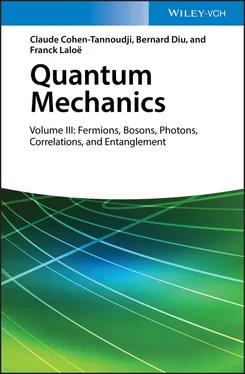9 Chapter: XXI QUANTUM ENTANGLEMENT, MEASUREMENTS, BELL’S INEQUALITIES A. Introducing entanglement, goals of this chapter B. Entangled states of two spin-1/2 systems C. Entanglement between more general systems D. Ideal measurement and entangled states E. “Which path” experiment: can one determine the path followed by the photon in Young’s double slit experiment? F. Entanglement, non-locality, Bell’s theorem COMPLEMENTS OF CHAPTER XXI, READER’S GUIDE Complement A XXIDensity operator and correlations; separability 1. Von Neumann statistical entropy 2. Differences between classical and quantum correlations 3. Separability Complement B XXIGHZ states, entanglement swapping 1. Sign contradiction in a GHZ state 2. Entanglement swapping Complement C XXIMeasurement induced relative phase between two condensates 1. Probabilities of single, double, etc. position measurements 2. Measurement induced enhancement of entanglement 3. Detection of a large number Q of particles Complement D XXIEmergence of a relative phase with spin condensates; macroscopic non-locality and the EPR argument 1. Two condensates with spins 2. Probabilities of the different measurement results 3. Discussion
10 Appendix IV: Feynman path integral 1. Quantum propagator of a particle 2. Interpretation in terms of classical histories 3. Discussion; a new quantization rule 4. Operators
11 Appendix V: Lagrange multipliers 1. Function of two variables 2. Function of AT variables
12 Appendix VI: Brief review of Quantum Statistical Mechanics 1. Statistical ensembles 2. Intensive or extensive physical quantities
13 Appendix VII: Wigner transform 1. Delta function of an operator 2. Wigner distribution of the density operator (spinless particle) 3. Wigner transform of an operator 4. Generalizations 5. Discussion: Wigner distribution and quantum effects
14 Bibliography of volume III
15 Index
16 End User License Agreement
1 Chapter XV Figure 1: Physical interaction between two identical particles: initially in the… Figure 2: Two diagrams representing schematically the two terms appearing in equ… Figure 3: Schematic representation of a direct term (left diagram where each par…
2 Complement BXV Figure 1: Quantum distribution functions of Fermi-Dirac  (for fermions, lower c… Figure 2: Variations of the particle number
(for fermions, lower c… Figure 2: Variations of the particle number  for an ideal fermion gas, as a fun… Figure 3: Variations of the total particle number
for an ideal fermion gas, as a fun… Figure 3: Variations of the total particle number  in a non-condensed ideal Bos…
in a non-condensed ideal Bos…
3 Complement CXV Figure 1: Variation as a function of the position x of the wave function φ(x) in…
4 Complement DXV Figure 1: Bogolubov spectrum: variations of the function ω(k) given by equation … Figure 2: A repulsive boson gas is contained in a toroidal box. All the bosons a… Figure 3: Plots of the energy of a rotating repulsive boson system, in a coheren…
5 Complement GXV Figure 1: Plot of the function x lnx. At x = 1, this curve is tangent to the lin…
6 Complement HXVFigure 1: Plots of the functions F (1)(solid line) and F (2)(dashed line) as a f…Figure 2: Plots of the functions F (1)(solid line) and F (2)(dashed line) in the…Figure 3: Beyond the critical point, the function F (1)intersects the first bise…Figure 4: Geometric solutions of equations (40) and (42) for a gas of repulsive …Figure 5: but for an attractive boson gas (where  is negative). When the attrac…
is negative). When the attrac…
7 Complement AXVIFigure 1: Plot of the function F ±(x) as a function of the dimensionless variabl…Figure 2: Plot, as a function of the dimensionless variable K F|r′′ – r|, of the…Figure 3: Plot of the function G 1(r; r′) = x 0+ Q(r – r′) for bosons, as a funct…
8 Chapter XVIIFigure 1: This diagram symbolizes the terms that come into play in the computati…Figure 2: Diagram symbolizing the pair-pair term of the binary correlation funct…
9 Chapter XVIIIFigure 1: For each vector k, the transverse fields can have two polarizations ch…
10 Complement AXIXFigure 1: Because of the recoil effect of the atom, the absorption and emission …Figure 2: Schematic diagram of a Zeeman slower. The atomic beam is cooled by a l…Figure 3: Principle of Doppler laser cooling. An atom moving with velocity υ alo…Figure 4: Populations σ bb(δ 1) and σ bb(δ 2) excited in the upper state by wave 1, …Figure 5: Principle of the magneto-optical trap. The transition used is a J g= 0…Figure 6: The external potential trapping the ion is the same when the ion is in…Figure 7: Saturated absorption spectroscopy. This figure plots the absorption pr…
11 Complement CXIXFigure 1: Selection rules for an electric or magnetic dipole transition. The mag…Figure 2: Energy diagram and Zeeman structure of the 6 1S 0→ 6 3P 1transition of t…Figure 3: Principle of optical pumping for a J g= 1/2 → J e= 1/2 transition. The…
12 Chapter XXFigure 1: The function to be integrated in expression (B-16) yielding the absorp…Figure 2: First diagram representation of the scattering processes labeled (α) a…Figure 3: Another possible diagram representation of the scattering processes (α…Figure 4: Raman scattering: an atom in state a absorbs an incident photon, with …Figure 5: The left-hand side of the figure represents a stimulated Raman process…
13 Complement AXXFigure 1: During a two-photon transition, the atom goes from state a to state a …Figure 2: Two diagrams schematizing a two-photon transition with a multimode sou…
14 Complement BXXFigure 1: Photoionization of an atom. State a is the ground state, state c one o…Figure 2: Atom A emits a photon described by a wave packet ϕ. This wave packet g…Figure 3: Intensity correlations in the resonance fluorescence of a single ion e…Figure 4: Two-photon photoionization. The atom goes from state a to state b, whi…Figure 5: Effective potential seen by an electron undergoing tunnel ionization.…
15 Complement CXXFigure 1: Energy levels of the system atom + photon in the absence of coupling.…Figure 2: Energies of the states of the system A + L within ε(N), in the absence…Figure 3: Non-perturbed states (left-hand side of the picture) and perturbed sta…Figure 4: Plots of the light shift ħδ g(dashed line curve) and of the radiative …Figure 5: The left-hand side of the figure represents the J g= 1/2 → J e= 1/2 tr…Figure 6: Energies of the dressed states |ψ ±(N)〉 (solid lines) and of the non-pe…Figure 7: Radiative transitions between one of the two states |ψ ±(N)〉 of multipl…Figure 8: Energy levels of the system atom + field for low values of the photon …
16 Complement DXXFigure 1: (a) A laser beam traveling within a block of glass (shaded in grey in …Figure 2: Schematic representation of a two-dimensional optical lattice: placed …Figure 3: Laser configuration with a space-dependent polarization: two laser wav…Figure 4: Transition 1/2 ↔ 3/2. The oblique upwards arrows show the transitions …Figure 5: Principle of Sisyphus cooling: an atom in state g +1/2moving from a po…
17 Complement EXXFigure 1: An incident photon, with angular frequency ω 0is scattered by an atomi…Figure 2: A pump beam with angular frequency ω 0, propagating along a direction w…
18 Chapter XXIFigure 1: Young’s double slit experiment using a plate P, mobile along the x axi…Figure 2: In an EPRB experiment, a source S emits pairs of particles in a single…Figure 3: Source S emits particles toward two measuring apparatus located far aw…Figure 4: Position of the four vecteurs a, b, a’ and b’ leading to a maximum vio…
Читать дальше

 (for fermions, lower c… Figure 2: Variations of the particle number
(for fermions, lower c… Figure 2: Variations of the particle number  for an ideal fermion gas, as a fun… Figure 3: Variations of the total particle number
for an ideal fermion gas, as a fun… Figure 3: Variations of the total particle number  in a non-condensed ideal Bos…
in a non-condensed ideal Bos… is negative). When the attrac…
is negative). When the attrac…










